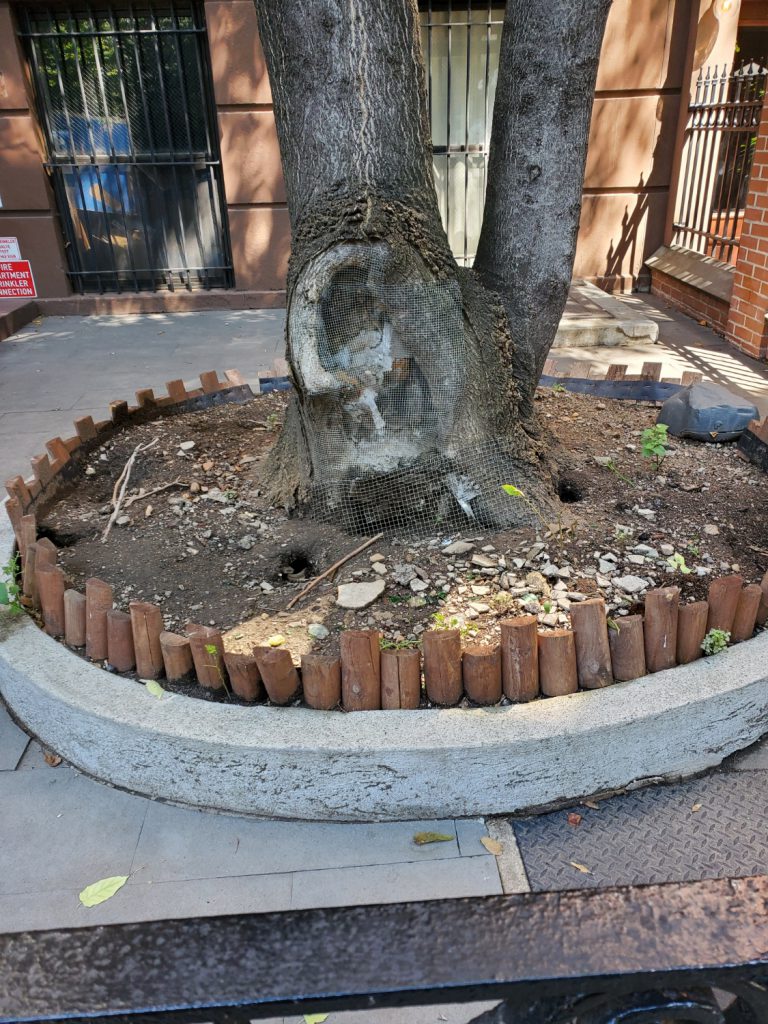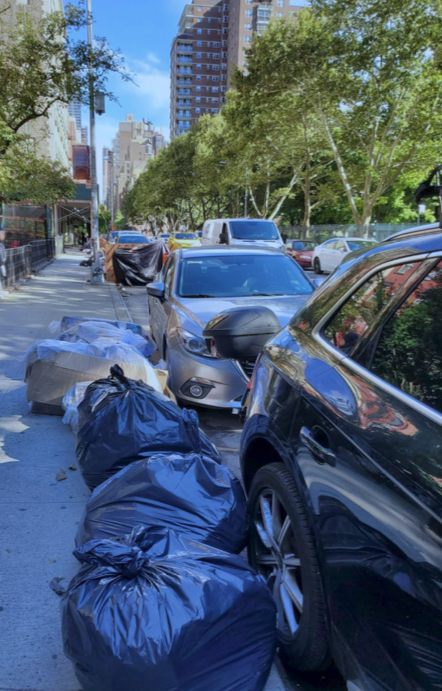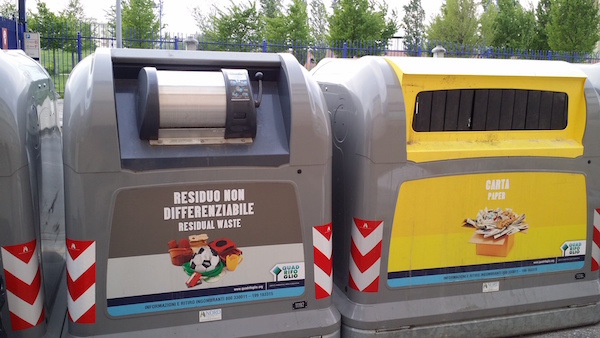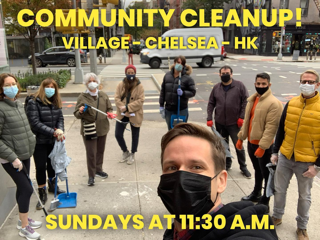
BY BONNIE ROSENSTOCK | In Part I, the myriad causes of the rat infestation plaguing the residents of the Lamartine Place Historic District (West 29th Street btw. Eighth & Ninth Aves.) were chronicled. To read Part I, click here. In this second and concluding installment, we continue the discussion and focus on solutions.
The October 6, 2021 walk-through organized by New York City Council Speaker Corey Johnson’s office included West 29th Street resident Fern Luskin and two others who reside on the same 300 block; Christopher Agazzi, New York City Department of Sanitation (DSNY), District Superintendent Manhattan 4; Matt Green, Deputy Chief of Staff/District Director for Speaker Johnson; Brittany Bowen, Speaker Johnson’s Liaison to Community Board 4; and from the New York City Department of Health and Mental Hygiene (DOHMH), Angela Stravitz, Supervising Case Manager, Veterinary and Pest Control Services and Frances Dottino, Case Manager/Public Health Sanitarian.
Eradication through chemistry is, at best, only a partial solution. “We need trash bins that are hinged and on wheels that can be taken to the curb by the Sanitation workers, and the elimination of the practice of leaving the black bags of garbage out on the curb during the night, which is an invitation to rats,” stated Luskin. “This is what other cities in the U.S. and in Europe do.” Agazzi said that residents are allowed to put metal garbage cans to the curb, but block residents on the tour said that cans were either stolen or neighbors complained about the banging noises when the garbage was picked up during the night.
Lamartine Place is slated to receive rat-proof garbage cans this fall, but they’re presently on back order due to pandemic-generated shipping delays. In the meantime, Green offered to get ACE, a non-profit supplemental sanitation service, to target the garbage cleanup on this historic block. ACE currently picks up garbage in Johnson’s District 3, on Eighth Ave. between 17th and 34th Sts., Thursdays through Sundays. In an October 12 phone interview with Chelsea Community News (CCNews), Green explained that they do all the things that Sanitation doesn’t, noting, “They sweep the sidewalks, sweep into the curb line, pick up litter and also refill and bag overflowing litter cans. They don’t have a truck, so they’re not hauling away trash like Sanitation, but they have a large wastebasket on wheels. We have them all over the district.”
He added, “A lot of BIDs [Business Improvement Districts] hire them. We fund them out of our discretionary funds and give to organizations like ACE and to DSNY for additional services.”
When Luskin complained about the open mesh public garbage cans on the corners, Agazzi said they were actually preferable to the closed lid models because they were able to accommodate more garbage. When the closed lid models fill up, he noted, people simply pile garbage on top of them. (People also throw food and beverages on top of the overflowing open mesh cans as well as on top of the black garbage bags.) At the end of the tour, Agazzi said he would replace the open mesh baskets with silver public garbage cans to see how they worked.
Luskin asked if they could have one of each on the corners, but he replied in the negative. Another option suggested was to have local businesses sponsor a basket, but Agazzi said that’s not ideal because someone has to then empty the bags. Others also didn’t think it should be up to businesses to sponsor public trash baskets. “The City should be responsible for providing adequate public trash bins,” Luskin said.
Closing the gap between what should and what can be done, the City offers its residents the opportunity to sponsor a basket.
“Businesses, organizations and New Yorkers supply pre-approved baskets to replace the City’s standard design. These higher-end baskets include a logo or name to highlight the sponsor’s commitment to maintaining the community’s quality of life,” the website states. To sponsor a basket or learn more about this initiative, email CustomerService@dsny.nyc.gov.

On the same website, DSNY offers an Adopt-a-Basket Program, in which they provide volunteers with a regular supply of free plastic liners, a collection schedule, work gloves and a dust bin and broom. The website states, “To help, monitor your litter baskets; when they’re three-quarters full, remove the used plastic liners, tie them, leave them next to the basket and insert a new liner. If you run out of plastic liners before your next delivery, just call 311 to request more.”
In an October 15 email to CCNews, DSNY Press Secretary Vincent Gragnani noted high-end litter baskets, which are more rat-proof than regular wastebaskets, are generally funded by the offices of local elected officials. “In this case, Speaker Johnson has allocated significant funding for these,” he said. “We typically place these out in the spring, and we expect them to be in place by then.”
Luskin also asked about the use of dry ice, which Boston effectively used to kill their rats. CCNews followed up with DOHMH about this, and on October 15, Michael Lanza, Deputy Press Secretary emailed, “Many agencies and private sector pest management firms in NYC use dry ice (on the market as “Rat Ice”). The product is also used by the Health Department and other City agencies, and we’ve seen success. It is not considered dangerous if the label directions are followed.”
Lanza added, “There are many techniques and strategies that can be used to control rats. The most effective and sustainable approach is called Integrated Pest Management (IPM). This method focuses on removing the underlying conditions that cause pests.”
What are the underlying conditions? Lanza replied, “Deny them food, water and shelter.”

In a July 15, 2021 email to Luskin, Dottino outlined many practical suggestions for controlling the rat invasion. She wrote, “If possible, have garbage put out on the curb as close to pick-up time as possible. This means if garbage pick-up is 7:00am on Wednesday, then putting it out as close to that time is ideal. I know this is not always possible…”
Dottino also recommended “contaminating” the garbage. “This is simply making a bleach solution of 1 part bleach 7 parts water and soaking a rag in it and putting it in the bag before closing it. You can also spray it on the exterior of the bags when they are put on the curb.”
Cleaning up rat feces is also of some urgency, for the diseases it generates. Indeed, hantavirus pulmonary syndrome (HPS) is a serious but rare viral respiratory disease transmitted by infected rodents through urine, droppings or saliva. HPS progresses quickly. Also, in September 2021, the NYC Department of Health and Mental Hygiene (DOHMH) reported 14 cases of leptospirosis, with an additional case at the beginning of October—an inordinately high number since there have only been a total of 57 cases in the 15 years since 2006. Leptospirosis is a rare but potentially fatal bacterial disease spread through contact with rat urine or contaminated water. It is treatable with antibiotics.
There are also about 16 canine cases a year, most likely caused by dogs drinking contaminated standing water in puddles. Canine to human transmission has not been documented. Additionally, no cases have been attributed to the flooding from Hurricane Ida or Hurricane Sandy in 2012. Climate change has also been a factor, since warm, humid environments contribute to higher rates of the disease.
“If rat feces are found on the sidewalk or concrete, then it is important to clean them immediately,” Dottino wrote. “First step is to sweep up the droppings. Then using the same bleach solution listed above, spray the solution on the ground, use a brush and clean the sidewalk. This should be done every time droppings are seen, but weekly is recommended. Garbage storage areas and cans on the exterior of buildings should be cleaned with the same solution, at minimum weekly if not every time the garbage is emptied.”
Erik Bottcher, who participated in the first walk-through in August 2020 as Speaker Johnson’s Chief of Staff, was unable to participate in the October 6, 2021 tour because he was in quarantine with a COVID diagnosis. On November 2, Bottcher—running unopposed as the Democratic candidate for term-limited Johnson’s Council seat—won that race. Prior to that, when he was one of six candidates anticipating the June 22, 2021 Primary, Bottcher’s “Clean District 3” sanitation plan (click here to view it) was a campaign hallmark.
The plan includes more trash pick-ups, DSNY “Strike Teams” that respond to 311 calls in real time, and new litter baskets. Bottcher wrote, “The standard wire waste bins currently found on the corners throughout New York City are antiquated, frequently in disrepair, and overflow quickly. I will fund the replacement of these wire baskets with new and modern high capacity bins at intersections throughout Council District 3.”
In a telephone interview with CCNews prior to his November 2 victory, Bottcher, who will begin his work as District 3 Councilmember on January 1, 2022, discussed some of his sanitation ideas.
“We need to think big when it comes to sanitation,” he said. “New Yorkers have accomplished a lot throughout history. There’s no reason we can’t be successful in addressing and improving our sanitation system.”
This reporter mentioned that other countries were ahead of us in many areas, including sanitation disposal management, and that when tourists visit the city, they are surprised how dirty it is. “We are utilizing 19th- and 20th-century sanitation systems,” Bottcher said. “The rest of the world has moved forward while we’ve failed to innovate. That needs to change.”

He acknowledged that the pandemic has created real complications with sanitation, partly because many property owners have been absent and other tenants, who might have been more attentive to sanitation issues, have been away. “But that’s no excuse for not maintaining cleanliness in front of one’s property. They need to fulfill that responsibility,” he said.
Bottcher also supports composting as a means of controlling the rat population. “The single most important thing we can do to prevent rodents and reduce our garbage in the streets is to embrace organic waste disposal through composting,” he said. “A very large percentage of the trash that goes to landfill is compostable organic waste. When that gets put on the sidewalk in plastic bags, it is basically a midnight buffet for rodents. We would be reducing unsightly trash placed on the sidewalks and reducing our carbon footprint at the same time. We need universal organic waste disposal. It’s been instituted in places like California. We’ve got to do it here.”
During the pandemic, he observed a slow-down in trash enforcement. “During my campaign for City Council, I organized weekly clean-ups in the Village, Chelsea and Hell’s Kitchen. I’m going to resume those when I take office. They were really effective in helping local residents be part of the solution.”

He is also a vocal proponent of pneumatic tube waste collection technology which has gained some local support. He said that it “holds great promise” and should be pursued in New York City. Pneumatic tubes are being used for new developments in many cities, including Seoul, Korea; Stockholm, Sweden; Bergen, Norway; Barcelona, Spain; Singapore and Doha, Qatar. The only place close to home where it is being utilized is Roosevelt Island, which launched its system in 1975 with the construction of its residential developments. After 46 years, it’s still functioning.
In his proposal, Bottcher writes, “Here in Council District 3, in the short term, a pneumatic tube should be installed underneath the High Line, which could transfer garbage from up and down the West Side to centralized collection locations, reducing truck traffic on our streets and becoming a model that could be used elsewhere.” He also advocates installing the technology in large complexes, like Penn South and NYCHA.
Addressing the immediate plight of Fern Luskin and her neighbors, Bottcher said, “We can’t rest until the rodent problem on West 29th Street is addressed. The City needs to step up to the plate as do property owners in abating the rodent infestation.”
Luskin and her neighbors have created an online petition, “Rat-Proof Our City with New Garbage Collection Policies,” addressed to Mayor Bill de Blasio and New York City Sanitation Commissioner Edward Grayson. The four points are, in brief, the City must require all buildings to have rat-proof garbage bins; the City must prevent leftover food from being strewn about by strictly enforcing littering laws; the City must have NYC Pest Control do more rat inspections; the City must exterminate the rats citywide. To view and sign the petition, click here.
Chelsea Community News is made possible with the help of our awesome advertisers, and the support of our readers. If you like what you see, please consider taking part in our GoFundMe campaign (click here). To make a direct donation, give feedback, or send a Letter to the Editor, email scott@chelseacommunitynews.com.

Pingback: This Week in Chelsea: January 3-9, 2022 – Chelsea Community News
Pingback: ‘Mischief’ of Rats Wreaking Havoc on West Chelsea Historic District – Chelsea Community News